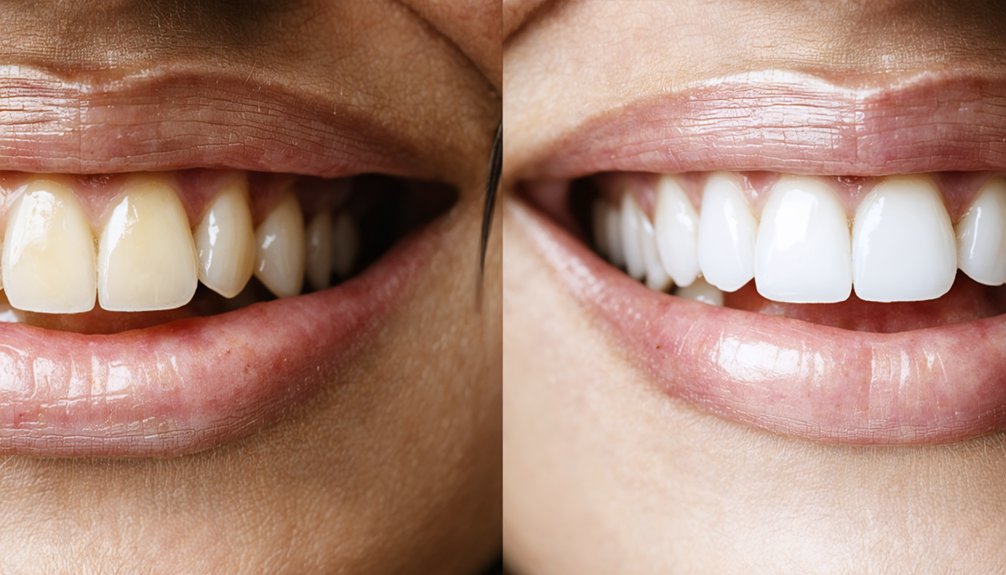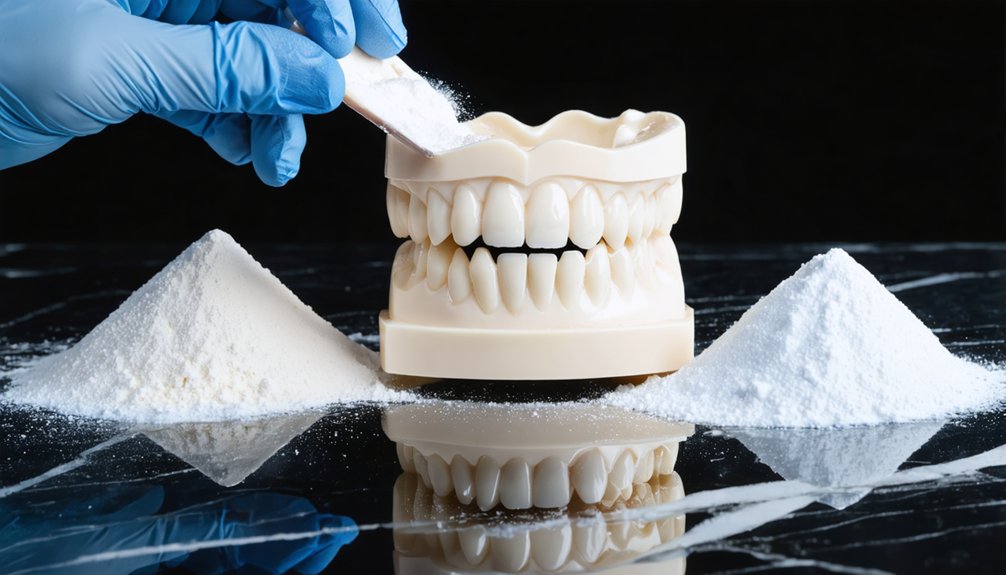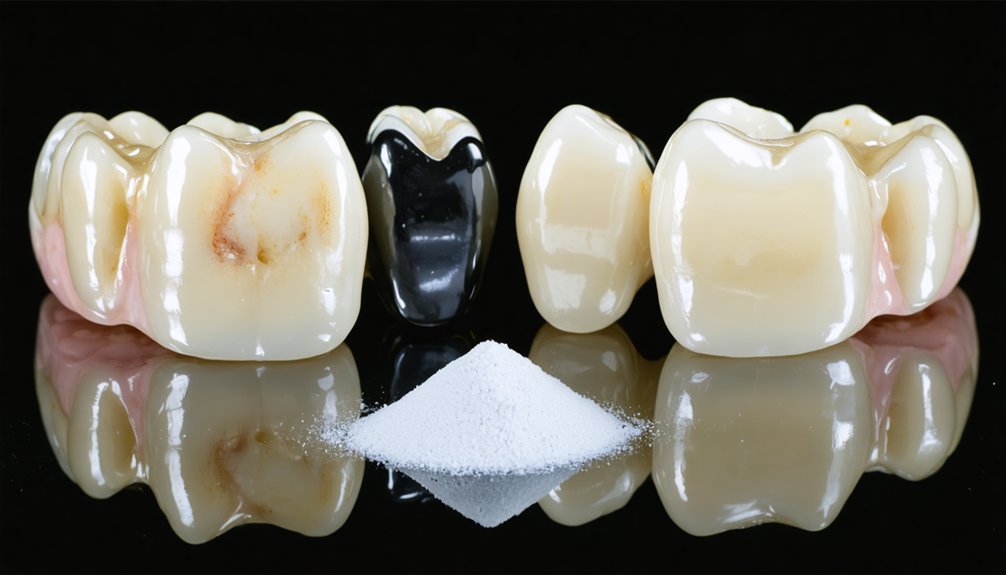You’ll get the best whitening results from tooth powders containing 20% carbamide peroxide, which can lighten teeth up to 12 shades in 14 days. For sensitive teeth, choose non-peroxide options with PAP or bromelain enzymes. Apply the powder to damp bristles and brush gently for 1-2 minutes, 2-3 times weekly. While over-the-counter options work well for surface stains, intrinsic discoloration may require professional evaluation to determine your ideal whitening approach.
Key Takeaways
- Carbamide peroxide-based tooth powders at 20% concentration deliver superior whitening results, especially for deep intrinsic stains.
- MySweetSmile powder achieves significant whitening without hydrogen peroxide, making it ideal for sensitive teeth and gums.
- Combinations of PAP, bromelain, and sodium bicarbonate effectively whiten teeth while protecting enamel health.
- Oralgen NuPearl powder demonstrates clinically proven shade improvements of 2.1 shades within one week of regular use.
- Regular use of peroxide-based tooth powders shows visible whitening within 7-14 days, with results lasting 3-6 months.
Understanding Tooth Discoloration and Whitening Powders
When examining tooth discoloration, it’s essential to understand both its internal and external causes.
You’ll encounter two main types: intrinsic discoloration, which occurs within the tooth structure, and extrinsic discoloration, caused by external factors like tobacco, coffee, and poor dental hygiene.
Southern U.S. residents report significantly higher rates of tooth discoloration compared to other regions.
Tooth whitening powders can effectively address extrinsic stains through mild abrasives and stain-absorbing ingredients like activated charcoal.
Whitening powders with gentle abrasives and activated charcoal work effectively to remove surface stains from teeth.
However, you should note that these products won’t greatly affect intrinsic discoloration caused by medications or trauma.
Before recommending whitening powder to your patients, consider the specific tooth discoloration causes they’re experiencing.
While regular use of whitening powders can maintain brightness for surface stains, intrinsic discoloration typically requires professional intervention.
Regular dental visits for professional cleanings can significantly improve overall tooth appearance and prevent future staining.
Always advise consulting a dental professional before starting any whitening regimen.
Top Ingredients That Power Effective Tooth Whitening
To achieve effective tooth whitening results, you’ll need to understand the key ingredients that drive the process. The most powerful tooth powder ingredients combine peroxide-based agents with gentle abrasives. Hydrogen peroxide and carbamide peroxide lead in whitening efficacy, targeting both surface stains and deeper discoloration.
For natural alternatives, sodium bicarbonate (baking soda) serves as an effective yet gentle abrasive that removes surface stains while buffering acids. When combined with hydrated silica, it creates a balanced mechanical action for stain removal. A clinical exam and history should be conducted before starting any whitening treatment to check for allergies and evaluate existing restorations. Essential oils can be added to enhance both taste and freshness.
PAP and bromelain offer non-peroxide options that safely eliminate artificial stains without damaging enamel. While activated charcoal and bentonite clay have gained popularity, they primarily work through mechanical action and show limited evidence for intrinsic whitening.
Clinical Evidence and Professional Endorsements
Clinical evidence strongly supports the effectiveness of tooth powders for whitening, though results vary considerably based on formulation and active ingredients.
Recent clinical trials demonstrate tooth powders can outperform traditional toothpaste in removing surface stains, particularly those containing sodium bicarbonate. Research shows 20% carbamide peroxide delivers superior whitening results compared to over-the-counter alternatives. Abrasive ingredients in tooth powders should be carefully monitored to prevent excessive wear of dental tissues.
Professional guidelines from the American Dental Association and dental experts recommend considering these key factors:
- Choose products with proven whitening agents like sodium bicarbonate or bromelain
- Consider gentler options if you have sensitive teeth or gums
- Follow recommended application methods from clinical studies
- Monitor results and adjust usage based on your specific needs
While professional treatments remain most effective, clinical evidence shows tooth powders offer a viable at-home alternative when used according to professional guidelines.
Safety Profile of Leading Whitening Powders
Leading whitening powder formulations now incorporate non-irritating active ingredients that have undergone extensive dermatological testing to guarantee safety.
The risk of gum tissue irritation can be minimized through proper application techniques and following product instructions carefully.
You’ll find that professionally endorsed products contain gentle whitening compounds that minimize tissue sensitivity while maintaining effectiveness.
These dermatologist-tested formulas provide ideal safety margins, especially for users with pre-existing tooth or gum sensitivities.
A dentist consultation is essential before starting any whitening powder treatment to ensure optimal safety and effectiveness for your specific needs.
Non-Irritating Active Ingredients
When choosing tooth whitening powders, several non-peroxide agents offer effective stain removal with minimal risk of irritation.
These gentler alternatives provide safer options for patients with sensitivity while still delivering noticeable results. Only use products with full ingredient disclosures for optimal safety. Professional monitoring can help prevent adverse dental effects from improper use.
Key non-irritating active ingredients include:
- PAP (Phthalimidoperoxycaproic acid) – removes artificial stains without damaging enamel or causing cytotoxicity
- Bromelain – natural enzymatic whitening that’s completely non-cytotoxic and effective at reducing stains
- Sodium bicarbonate – safely removes surface stains while leaving a protective residue layer
- Hydrated silica – gentle abrasive that’s medically safe at proper concentrations
For ideal results, look for formulations that combine these non-irritating agents with remineralizing ingredients like fluoride compounds to support enamel health during the whitening process.
Dermatologist-Tested Whitening Formulas
Building on the benefits of non-irritating ingredients, safety testing of tooth whitening powders remains a top priority for manufacturers and dental professionals.
While dermatologist recommendations aren’t commonly found for tooth powders, dental professionals evaluate these products primarily for oral safety. Testing standards focus on measuring abrasivity levels and potential enamel damage.
You’ll find that most dentists favor professional peroxide-based treatments for significant whitening, viewing powders as supplementary maintenance options.
When choosing a powder, look for formulations with gentle abrasives like calcium carbonate or hydroxyapatite. These ingredients have demonstrated lower risks of enamel wear and gum irritation.
Be aware that many commercial powders claiming “natural” ingredients lack thorough clinical safety data, as they’re not subject to the same rigorous FDA oversight as peroxide-based whitening products.
Real User Results and Success Stories

You’ll notice visible whitening changes within 7-14 days when using peroxide-based tooth powders, as documented in both clinical trials and real user experiences.
Before-and-after photos from users demonstrate that baking soda-based powders produce gradual but consistent whitening effects, particularly for surface stains.
Long-term success requires maintaining proper application techniques and following recommended usage frequencies, with many users reporting sustained results after 3-6 months of regular use.
Visible Changes Within Days
Real users consistently report visible whitening results within specific timeframes when using tooth powder products.
You’ll notice visible improvements based on your stain type and application frequency, with most users seeing changes within the first two weeks of proper use.
For best whitening results, expect these progressive changes:
- Surface stains begin lifting within 7-14 days of regular use
- Moderate discoloration shows improvement after 2-4 weeks
- Coffee and tea stains respond best to PAP and diamond powder formulations
- Ideal results appear when using whitening powder 2-3 times weekly
Products containing PAP, hydroxyapatite, and diamond powder combinations deliver the fastest visible changes while protecting your enamel.
For stubborn stains, supplementing with fluoride whitening toothpaste helps maintain and enhance your results.
Before and After Stories
The transformative power of tooth powder becomes evident through countless before-and-after success stories shared by users worldwide. Users report dramatic improvements of up to 12 shades lighter, with noticeable results appearing within days of consistent use.
Product comparisons reveal that MySweetSmile powder users experience significant whitening without hydrogen peroxide, while SNOW and Oralgen systems demonstrate compelling results in just one week.
Real user experiences highlight how younger individuals often achieve faster results, though success spans all age groups. A notable example includes a 29-year-old female who documented remarkable improvement using tooth powder treatments.
You’ll find that results vary based on factors like tooth porosity and lifestyle habits, but maintaining proper application techniques and following maintenance protocols consistently leads to successful outcomes.
Long-Term Whitening Success
While short-term whitening results can be encouraging, long-term success requires understanding the scientific mechanisms behind different whitening agents.
Research shows that carbamide peroxide-based professional at-home trays deliver the most reliable whitening durability, consistently outperforming other methods.
For ideal long term effects, consider these clinically proven approaches:
- Use 10-20% carbamide peroxide trays under professional supervision for stable, lasting results.
- Combine enzymatic agents like bromelain with peroxide treatments to minimize sensitivity while maintaining effectiveness.
- Avoid relying solely on Blue Covarine products, as they only mask discoloration temporarily.
- Supplement professional treatments with baking soda-based maintenance for surface stain control.
Remember that temporary sensitivity typically resolves post-treatment, while the whitening benefits can persist for months with proper care.
Proper Application Methods for Maximum Results

Achieving ideal results with tooth whitening powder requires careful attention to proper application techniques and timing.
Start by slightly dampening your toothbrush bristles and shaking off excess water. Apply a small amount of powder evenly across the brush tips. Use gentle circular motions while brushing, focusing on stained areas without applying excessive pressure. You’ll want to brush for 1-2 minutes to guarantee adequate stain removal.
For best frequency, limit powder use to 2-3 times weekly to protect your enamel. Rinse thoroughly afterward, swishing multiple times to remove all particles. Follow up with fluoride toothpaste to strengthen your enamel.
Don’t brush with powder immediately after acidic meals, and if you have sensitive teeth, consult your dentist before starting a whitening regimen.
Comparing Popular Whitening Powder Brands
Modern whitening powder brands offer distinct formulations and approaches to teeth whitening, ranging from peroxide-based compounds to natural minerals.
When comparing tooth powder effectiveness, Akami stands out with its food-grade ingredients and proven remineralization properties. Miyanxii, while strong in breath freshening, delivers less impressive whitening results despite containing hydrogen peroxide.
For those seeking gradual but sustainable results, consider these key brand distinctions:
- Oralgen NuPearl achieves 2.1 shade improvements within one week.
- Smilepro’s LED-activated formula produces visible results in days.
- Living Well excels in enamel strengthening, supporting natural whitening.
- Bubchen uses mild abrasives for gentle stain removal without damaging enamel.
Choose based on your specific needs, weighing factors like speed of results versus enamel protection.
Frequently Asked Questions
Can Whitening Tooth Powder Remove Stains Caused by Medications or Antibiotics?
You’ll find that tooth powder alone can’t effectively remove deep medication stains or antibiotic effects. For these intrinsic discolorations, you’ll need professional dental treatment with higher-concentration whitening agents.
How Long Do Whitening Results Last After Stopping Tooth Powder Use?
Like morning frost melting away, your whitening results typically last 2-4 months after stopping powder use. You’ll need regular fluoride toothpaste and good oral hygiene to maintain brightness longer.
Is It Safe to Use Whitening Tooth Powder With Dental Crowns or Veneers?
You’ll need dental consultation first, as whitening powders can cause sensitivity issues and uneven coloring with crowns/veneers. It’s safer to use non-peroxide, low-abrasive options under professional guidance.
Can Children or Teenagers Safely Use Tooth Whitening Powder Products?
You shouldn’t let children use whitening powder due to safety concerns. Wait until at least age 14 when permanent teeth are fully developed. Consult a dentist first due to age restrictions and risks.
Does Smoking Affect the Effectiveness of Tooth Whitening Powder Treatments?
While smoking doesn’t affect tooth sensitivity during whitening, it’ll considerably reduce your treatment’s effectiveness. Longer smoking duration creates deeper stains that resist powder whitening, requiring professional-grade treatments instead.
References
- https://www.madebydentists.com/products/teeth-whitening-powder
- https://mysweetsmile.com/en-us/products/teeth-whitening-powder
- https://www.goodhousekeeping.com/health-products/g28723133/best-at-home-teeth-whitening-products/
- https://my.clevelandclinic.org/health/symptoms/10958-tooth-discoloration
- https://pmc.ncbi.nlm.nih.gov/articles/PMC6937148/
- https://pmc.ncbi.nlm.nih.gov/articles/PMC4111029/
- https://imagixdental.com/where-in-the-us-are-people-most-likely-to-have-discolored-teeth
- https://www.opnwide.com/causes-of-tooth-discoloration/
- https://compassdentalgroup.com/top-3-causes-of-tooth-discoloration/
- https://omaha.mypediatricdentalspecialists.com/10-tooth-discoloration/



